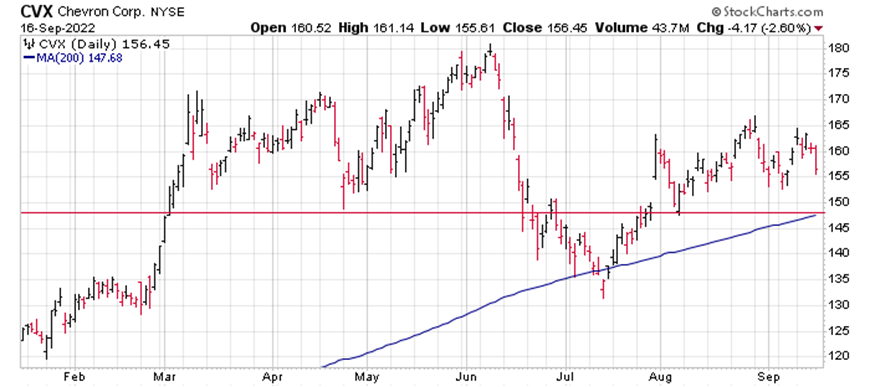
Pumped Up
Much is made of gas prices declining for so many weeks in a row (I think we’re at 13 and counting). And that’s great for drivers. But what about the oil companies. Don’t they suffer when pump prices decline? Apparently not.
Gas prices peaked in mid-June and have dropped about 25% since then. But Chevron (CVX) has gained more than 5% during that period. For the year, CVX is up 33%. Its only major blip this year was the June swoon that pulled all stocks lower. But the decline was supported by the 200-day moving average, which allowed just a handful of daily closes below it in mid-July.
This trade is based on the strength of oil companies continuing for the next couple of months. More specifically, it is relying on the continued support of the 200-day. Note that the short put of our spread is right on the 200-day (blue line) and will be below it given the trendline’s current slope. Thus, CVX will have to penetrate that support to move the spread into the money.

If you agree that CVX will respect the 200-day, consider the following trade that relies on the stock staying above $148 (red line) through expiration in six weeks:
Buy to Open the CVX 28Oct 145 put (CVX221028P145)
Sell to Open the CVX 28Oct 148 put (CVX221028P148) for a credit of $0.75 (selling a vertical)
This credit is $0.05 less than the mid-point price of the spread at Friday’s $156.45 close. Unless CVX pops quickly, you should be able to get close to that price.
The commission on this trade should be no more than $1.30 per spread. Each spread would then yield $73.70. This trade reduces your buying power by $300, making your net investment $226.30 per spread ($300 – $73.70). If CVX closes above $148 on October 28, both options will expire worthless and your return on the spread would be 33% ($73.70/$226.30).

Follow Terry's Tips on Twitter
Like Terry's Tips on Facebook
Watch Terry's Tips on YouTube